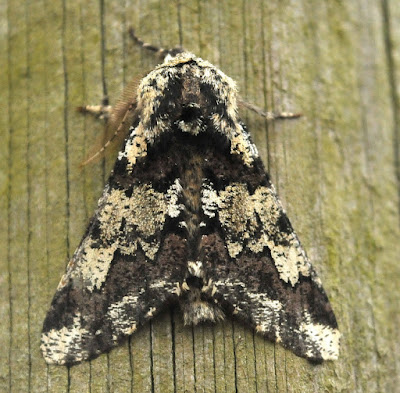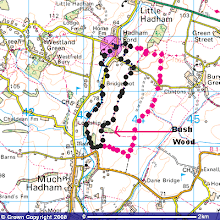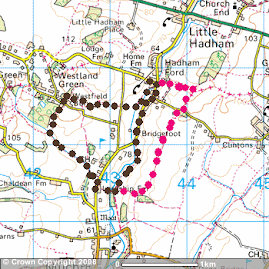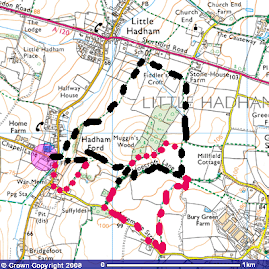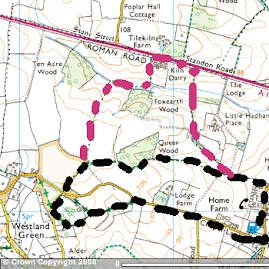Every birder has a bird that is elusive to them. For me, it's bluethroat. They are regular in The Camargue, Southern Portugal, Poland etc but on all my trips there I have never encountered one. A male turned up at Amwell NR several years ago, but had flown by the time I got there and on numerous occasions, I have failed to find one on the North Norfolk coast. I just put it down as "the bird I'll never see"
After an hour on the beach in -3C and very windy conditions, I thought I may have a look for these bluethroats, pointing out to Jack that I really ought to ring folk before I head to Dunge as I miss so much.
I arrived at the gully and immediately, a bluethroat popped up in front of me. The sky was dark, snow swirling and the bird was on mud: tricky light conditions for photos. These were the best I could manage. The bird showing a full blue bib, bordered by a hint of black and then red.
Pleased with this sighting, I set off for the RSPB reserve in increasingly freezing conditions. I treated myself to a proper thermal hat, donned my thick gloves and set off. A peregrine chased wigeon, a marsh harrier quartered the reedbeds, and a slavonian grebe slept on the water at Dengemarsh hide. Superb birds. A coffee warmed me up back at the Visitors' Centre before a wander to the ARC pit. More wildfowl, another marsh harrier before I checked willows for small migrants. A chiffchaff was my reward for standing in a gale that meant it felt like -6C.
Back to the car and off to Scotney Pits where oystercatchers and curlew got on to the day list. At this point the sun emerged so, instead of heading off to Oare Marshes near Faversham, I decided to head back to see if I could improve on the bluethroat shots. I returned to find a second bird, sporting a white dot on the blue bib. Two in one day and none for 59 years and 11 months!! Typical.
Firecrests flitted through the gorse and a caspian gull was noted roosting with 100's of great black backs, lesser black backed and herring gulls.
I managed a few photos of the 2nd bluethroat before heading home, getting through the Dartford tunnel just before 5.15 without any delay.
A truly memorable birding day for me. I am still trying to remember what was the last bird I saw in the UK that was new to me from anywhere in the world. Think it may have been Leach's storm petrel on a visit to Wallasey to see relatives before a Liverpool football game. That must have been in the early to mid 1990's!!
Edit: It was the western sandpiper at Cley when Wendy and I were staying at The George for a few nights. Must be several years ago now 2010/11/12 ish?
 |
| Great crested grebe in full plumage |
 |
| Slavonian grebe in winter plumage, but calling for a mate. |
 |
| Due to lack of mate, he went to sleep |
 |
| female Marsh harrier |
 |
| Male marsh harrier being mobbed by a carrion crow |
 |
| 2nd bluethroat with white dot |
Species list for the Day:
- red throated diver
- slavonian grebe
- little grebe
- great crested grebe
- gannet
- cormorant
- little egret
- grey heron
- mute swan
- greylag goose
- canada goose
- barnacle goose
- egyptian goose
- mallard
- gadwall
- shoveler
- wigeon
- teal
- pochard
- tufted duck
- common scoter
- goldeneye
- marsh harrier
- common buzzard
- kestrel
- peregrine falcon
- pheasant
- moorhen
- coot
- oystercatcher
- ringed plover
- lapwing
- dunlin
- curlew
- black headed gull
- common gull
- herring gull
- lesser black backed gull
- greater black backed gull
- caspian gull
- guillemot
- razorbill
- stock dove
- wood pigeon
- collared dove
- green woodpecker
- skylark
- meadow pipit
- pied wagtial
- wren
- dunnock
- robin
- bluethroat
- mistle thrush
- fieldfare
- redwing
- song thrush
- blackbird
- firecrest
- chiffchaff
- great tit
- blue tit
- marsh tit
- magpie
- carrion crow
- jackdaw
- rook
- starling
- house sparrow
- tree sparrow
- chaffinch
- linnet
- goldfinch
- greenfinch
- reed bunting.
8 new birds for the year list and one never seen before. Excellent day, finishing off with this superb firecrest.












